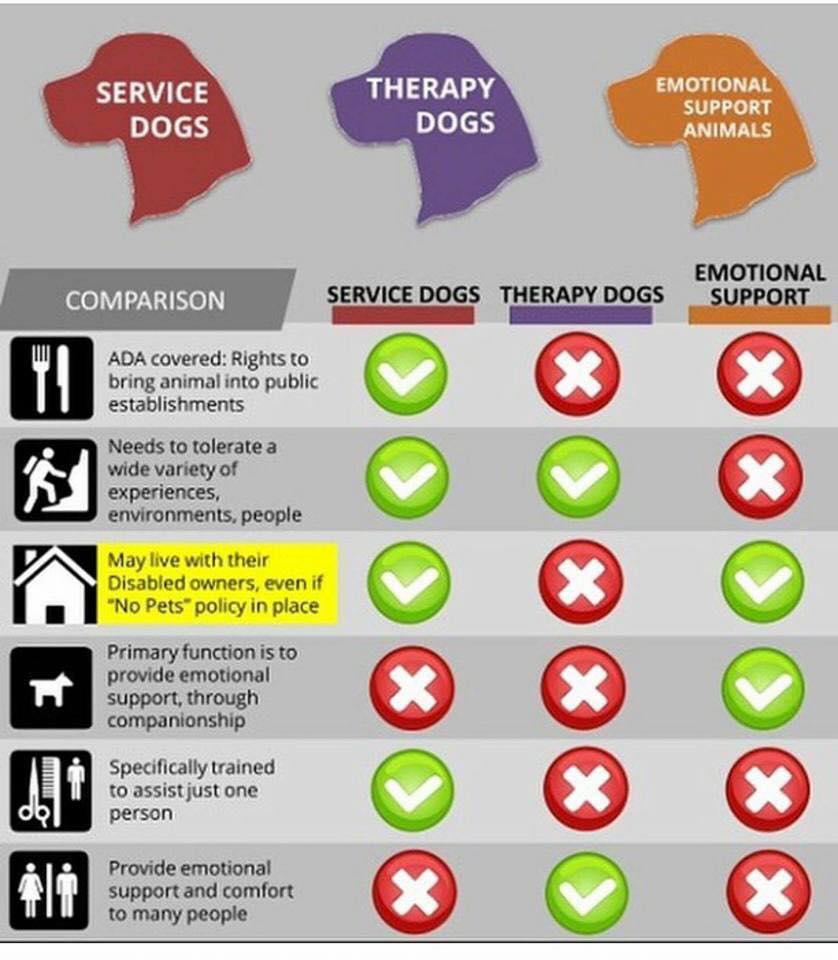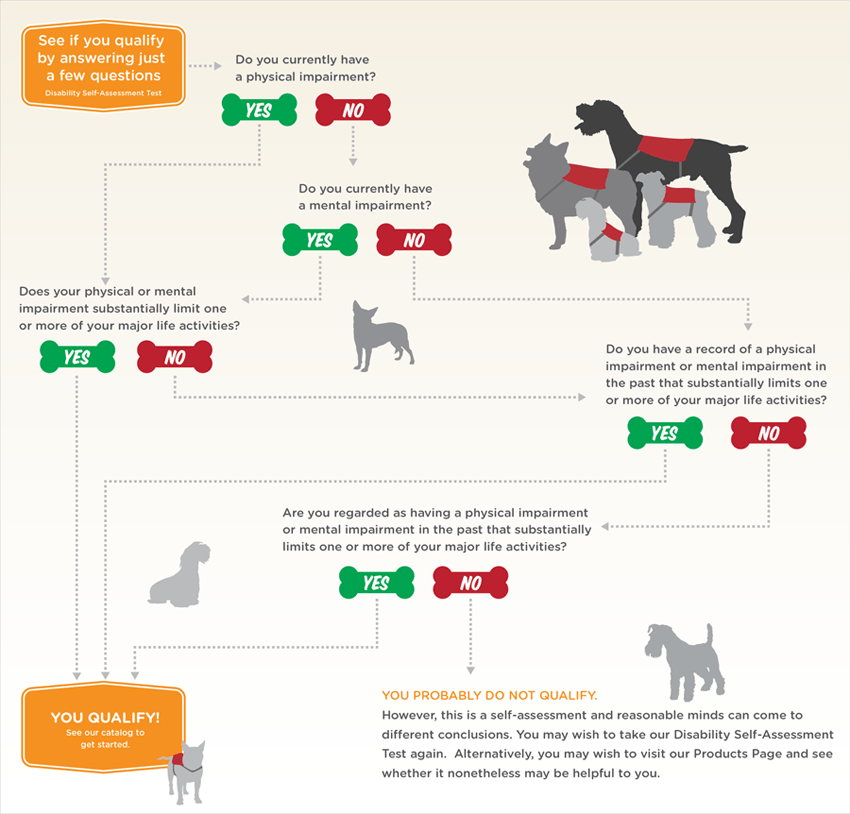What Are Service Animals?
To eliminate the confusion over whether you have a service animal, therapy dog or an emotional support animal, we made this page to help you.

Do You Qualify As Having a Disability?
A SERVICE ANIMAL is any dog that is individually trained to do work or perform tasks for the benefit of an individual with a disability, including a physical, sensory, psychiatric, intellectual, or other mental disability. The work or tasks performed by service animals must be directly related to the individual’s disability.
Click here for prices and Availability of service dogs available for sale.
Tasks Service Animals like Hattie help disabled people with:
- assisting individuals who are blind or have low vision with navigation and other tasks
- alerting individuals who are deaf or hard of hearing to the presence of people or sounds
- providing non-violent protection or rescue work
- pulling a wheelchair
- assisting an individual during a seizure
- alerting individuals to the presence of allergens
- retrieving items such as medicine or the telephone
- providing physical support and assistance with balance and stability to individuals with mobility disabilities
- helping individuals with psychiatric and neurological disabilities by preventing or interrupting impulsive or destructive behaviors
The crime deterrent effects of a service animal’s presence and the provision of emotional support, well-being, comfort, or companionship are not considered work or tasks for purposes of the definition of a service animal.
The ADA defines “disability” very broadly and does not limit the type of disability for which a service animal can be used. In addition, there is great flexibility with respect to the nature and severity of a person’s physical, mental, or emotional issue (disability). The essence of the law states that if you have any condition that makes it difficult to perform or limits an important life activity (that other people can perform easily), you are qualified. You are not required to have a doctor’s excuse or formal diagnosis to have a service animal. The life activity might only be a problem during certain times, like dizziness (leading to balance problems), low blood sugar, a seizure, panic attacks, stress, or depression, to name a few examples.
Although we do not encourage exaggerating problems to qualify as disabled, it is clear that you don’t have to be blind or deaf to have a disability. Are you diabetic? Then you probably qualify if your blood sugar level sometimes incapacitates you or makes normal functions difficult. Do you have dizziness or balance problems on occasion? How about difficulty hearing?
SERVICE ANIMAL TRAINING
Partial List of Qualified Disabilities to get a Service Animal Sacramento:
| Physical Problem Asthma (or other breathing problems) Blindness (& partial blindness) Deafness (& partial deafness) Diabetes Dizziness/Balance problems Epilepsy General Hearing Difficulty Mobility Problems Neurological Problems Paralysis Physical Weakness Speech Problems Seizures |
Emotional/Mental Problem Age-Related Cognitive Decline Any Psychiatric Condition (see exclusions below) Autism Depression Dyslexia Bipolar Disorder Emotionally Overwhelmed Panic Attacks Post Traumatic Stress Disorder (PTSD) Separation Anxiety Social Phobia Stress Problems |
ADA Definitions of Qualified Disability for Service Animals
Under the ADA, an individual with a disability is a person who:
- Has a physical or mental impairment that substantially limits one or more major life activities;
- Has a record of such an impairment; or
- Is regarded as having such an impairment.
A physical impairment is defined by the ADA as:
Any physiological disorder or condition, cosmetic disfigurement, or anatomical loss affecting one or more of the following body systems: neurological, musculoskeletal, special sense organs, respiratory (including speech organs), cardiovascular, reproductive, digestive, genitourinary, hemic and lymphatic, skin, and endocrine.
A mental impairment is defined by the ADA as:
Any mental or psychological disorder, such as mental retardation, organic brain syndrome, emotional or mental illness, and specific learning disabilities.
NOTE: The ADA does not list all conditions or diseases that make up physical, mental, and emotional impairments, because it would be impossible to provide a comprehensive list given the variety of possible impairments.
Exclusions to the Qualified Disability Definition
Neither deviant behavior (e.g., political, religious, or sexual) nor conflicts that are primarily between the individual and society are mental disorders unless the deviance or conflict is a symptom of a dysfunction in the individual. According to Title II of the American with Disabilities Act of 1990, current or future interpretation of psychological disabilities excludes common personality traits such as poor judgment or a quick temper.
What Kinds of Facilities are Places of Public Accommodation?
A “place of public accommodation” includes almost every type of operation which is open for business or which comes in contact with the general public. Specifically, it includes any commercial facility, operated by a private entity (not the government), whose operations fall within at least one of 12 different categories. A disabled person is protected by law to be accompanied by a service animal in the following areas:
- Places of lodging.
Examples: An inn, a hotel, a motel. - Establishments serving food or drink.
Examples: A restaurant, a bar. - Places of exhibition or entertainment.
Examples: A movie house, a theater, a concert hall, a stadium. - Places of public gathering.
Examples: An auditorium, a convention center, a lecture hall. - Sales or rental establishments.
Examples: A bakery, a grocery store, a clothing store, a hardware store, a shopping center, bookstores, video rental stores, car rental places, pet stores, jewelry stores. - Service establishments.
Examples: A laundromat or dry cleaner; a bank, a barber shop, a travel service, a shoe repair shop, a funeral parlor, a gas station, a lawyer’s or doctor’s office, a pharmacy, an insurance office, a hospital. - Stations for public transportation.
Examples: A terminal, a depot, or other station for transportation by bus, train, or airplane. - Places of public display or collection.
Examples: A museum, a library, a gallery. - Places of recreation.
Examples: A park, a zoo, an amusement park. - Places of education.
Examples: A nursery or pre-school, an elementary, secondary, undergraduate or postgraduate private school. - Social service center establishments.
Examples: A day care center, a senior citizen center, a homeless shelter, a food bank, an adoption agency, substance abuse treatment centers, rape crisis centers, halfway houses. - Places of exercise or recreation.
Examples: A gym, a health spa, a bowling alley, a golf course.
Note: A public accommodation cannot refuse to serve you because its insurance coverage or rates are conditioned on the absence of persons with disabilities.
Private Clubs and Religious Organizations Are Not Considered Public Accommodations
Title III of the ADA does not apply to:
- Private clubs, not open to the public
- Religious organizations and places of worship
Asking questions
To determine if an animal is a service animal in Sacramento, a public entity or a private business may ask two questions:
- Is this service animal required because of a disability?
- What work or task has this service animal been trained to perform?
These questions may not be asked if the need for the service animal is obvious (e.g., the dog is guiding an individual who is blind or is pulling a person’s wheelchair). A public entity or private business may not ask about the nature or extent of an individual’s disability or require documentation, such as proof that the animal has been certified, trained or licensed as a service animal, or require the animal to wear an identifying vest.
When and Where a Service Animal is Allowed Access
Individuals with disabilities can bring their service animals in all areas of public facilities and private businesses where members of the public, program participants, clients, customers, patrons, or invitees are allowed. A service animal can be excluded from a facility if its presence interferes with legitimate safety requirements of the facility (e.g., from a surgery or burn unit in a hospital in which a sterile field is required).
A public entity or a private business may ask an individual with a disability to remove a service animal if the animal is not housebroken or is out of control and the individual is not able to control it. A service animal must have a harness, leash or other tether, unless the handler is unable to use a tether because of a disability or the use of a tether would interfere with the service animal’s ability to safely perform its work or tasks. In these cases, the service animal must be under the handler’s control through voice commands, hand signals, or other effective means. If a service animal is excluded, the individual with a disability must still be offered the opportunity to obtain goods, services, and accommodations without having the service animal on the premises.
Service Dog School of America is the only Service Animal trainer in America teaching Off-Leash Training without using shock collars.

